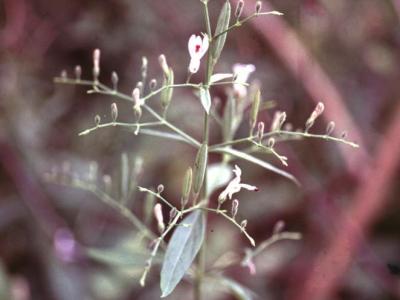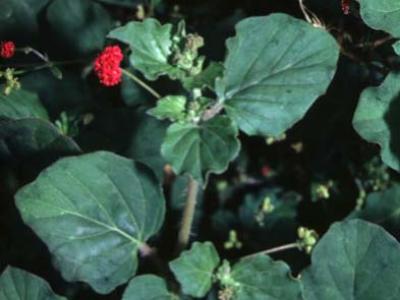(dans les territoires avec usage significatif TRAMIL)
Jamaïque:
- rice bitters
parties aériennes ou plante entière, fraîche ou sèche, décoction, voie orale1
*dépuratif : mesure prophylactique prise pour maintenir la santé par l'amélioration de la désintoxication et aider à réduire l'accumulation de déchets métaboliques dans le corps. Certains enquêtés ont dit que le « nettoyage » du sang résout tout problème de peau1.
Selon l’information disponible :
L’emploi des parties aériennes ou de la plante entière en décoction par voie orale comme dépuratif est classé REC sur la base de l’usage significatif traditionnel documenté par les enquêtes TRAMIL, les études de toxicité et l’information scientifique publiée.
Ne pas employer avec des femmes enceintes ou allaitantes2-3, ni avec des enfants de moins de 12 ans.
Pour le “blood cleanse” (dépuratif) :
Préparer une décoction avec 3 grammes de parties aériennes ou de la plante entière dans 1 tasse d’eau (250 mL). Faire bouillir 10 minutes dans un récipient couvert. Laisser refroidir, filtrer et boire 2 tasses par jour.
Toute préparation médicinale doit être conservée au froid et utilisée dans les 24 heures.
1 PICKING D, MITCHELL S, DELGODA R, YOUNGER N, 2011
TRAMIL survey. Natural Products Institute, The Biotechnology Centre & Tropical Metabolic Research Institute, University of the West Indies, Mona, Jamaica.
2 BONE K, 1999
Clinical applications of Ayurvedic and Chinese Herbs. Queensland, Australia: Phytotherapy Press.
3 WHO, 2004
Herba Andrographidis. WHO monographs on selected medicinal plants, Vol 2. Geneva, Switzerland. p20.
4 SHARMA A, KRISHAN L, HANDA SS, 1992
Standardization of the Indian crude drug kalmegh by high pressure liquid chromatographic determination of andrographolide. Phytochem Anal 3:129-131.
5 WEIMING C, XIAOTIAN L, 1982
Deoxyandrographolide-19beta-D-glucoside from the leaves of Andrographis paniculata. Planta Med 45:245-246.
6 CHEM W, LIANG X, 1982
Deoxyandrographolide 19ß-D-glucoside from the leaves of A. paniculata. Planta Medica 15:245-246.
7 SIRIPONG P, KONGKATHIP B, PREECHANUKOOL K, PICHA P, TUNSUWAN K, TAYLOR WC, 1992
Cytotoxic diterpenoid constituents from Andrographis paniculata, Nees leaves, J Sci Soc Th 18:187-194.
8 KEEFE JH, GHEEWALA NM, O'KEEFE JO, 2008
Dietary strategies for improving post-prandial glucose, lipids, inflammation and cardiovascular health. J Am Coll Cardiol 51:249-255.
9 HONG YH, CHAO WW, CHEN ML, LIN BF, 2009
Ethyl acetate extracts of alfalfa (Medicago sativa L.) sprouts inhibit lipopolysaccharide induced inflammation in vitro and in vivo. J Biomed Sci 16:64-75.
10 CHANG HM, BUT PPH, 1986
Pharmacology and applications of Chinese materia medica. Vol. 1. Singapore, World Scientific 1:918-928.
11 MATSUDA T, KUROYANAGI M, SUGIYAMA S, 1994
Cell differentiation-inducing diterpenes from Andrographis paniculata Nees. Chem Pharm Bull (Tokyo) 42:1216-1225.
12 KOTESWARA RAO Y, VIMALAMMA G, RAO CV, TZENG YM, 2004
Flavonoids and andrographolides from Andrographis paniculata. Phytochemistry 65:2317-2321.
13 RAO YK, VIMALAMMA G, RAO CV, TZENG Y, 2004
Flavonoids and andrographolides from Andrographis paniculata. Phytochemistry 65:2317-2321.
14 RAO YK, VIMALAMMA G, RAO CV, TZENG Y, 2010
A new diterpene from the leaves of Andrographis paniculata Nees. Fitoterapia 81(6):610-613.
15 ZAIDAN MRS, NOOR RA, BADRUL AR, ADLIN A, NORAZAH A, ZAKIAH I, 2005
In vitro screening of five local medicinal plants for antibacterial activity using disc diffusion method. Tropical Biomedicine 22(2):165-170.
16 GEORGE M, PANDALAI KM, 1949
Investigations on plant antibiotics. Part IV. Further search for antibiotic substances in Indian medicinal plants. Indian J of Medical Research 37:169–181.
17 NAKANISHI K, SASAKI S, KIANG AK, GOH J, KAKISAWA H, OHASHI M, GOTO M, WATANABE J, YOKOTANI H, MATSUMURA C, TOGASHI M, 1965
Phytochemical survey of Malaysian plants: preliminary chemical and pharmacological screening. Chem Pharm Bull 13:882–890.
18 LEELARASAMEE A, TRAKULSOMBOON S, SITTISOMWONG N, 1990
Undetectable antibacterial activity of Andrographis paniculata (Burm) Wall. ex Nees. J of the Medical Association of Thailand 73(6):299–304.
19 CHATURVEDI GN, 1983
Clinical studies on kalmegh (Andrographis paniculata) in infectious hepatitis. J of the International Institute of Ayurveda 2:208–211.
20 PURI A, SAXENA R, SAXENA RP, SAXENA KC, SRIVASTAVA V, TANDON JS, 1993
Immunostimulant agents from Andrographis paniculata. J Nat Prod, 56(7):995–999.
21 JARUKAMJORN K, DON-IN K, MAKEJARUSKUL C, LAHA T, DAODEE S, PEARAKSA P, SRIPANIDKULCHAI BO, 2006
Impact of Andrographis paniculata crude extract on mouse hepatic cytochrome P450 enzymes. J Ethnopharmacol 105(3):464-467.
22 CHOUDHURY BR, PODDAR MK, 1984
Andrographolide and kalmegh (Andrographis paniculata) extract: in vivo and in vitro effect on hepatic lipid peroxidation. Methods Find Exp Clin Pharmacol 6(9):481-485.
23 MELCHIOR J, PALM S, WIKMAN G, 1996
Controlled clinical study of standardized Andrographis paniculata extract in common cold. Phytomedicine 3(4):315-318.
24 GABRIELIAN ES, SHUKARIAN AK, GOUKASOVA GI, CHANDANIAN GL, PANOSSIAN AG, WIKMAN G, WAGNER H, 2002
A double blind, placebo-controlled study of Andrographis paniculata fixed combination Kan Jang in the treatment of acute upper respiratory tract infections including sinusitis. Phytomedicine 9(7): 589–597.
25 CHANDER R, SRIVASTAVA V, TANDON JS, KAPOOR NK, 1995
Antihepatotoxic activity of diterpenes of Andrographis paniculata (kalmegh) against Plasmodium berghei-induced hepatic damage in Mastomys natalensis. Pharm Biol 33:135-138.
26 DHAMMAUPAKORN P, CHAICHANTIPYUTH C, 1989
Acute and subchronic toxicity studies of Andrographis paniculata in rats and mice. Abstr. the 8th Symp, Faculty of Pharmacy, Chulalongkorn University Bangkok, Thailand.
27 VEDAVATHY S, RAO KN, 1991
Antipyretic activity of six indigenous medicinal plants of Tirumala Hills, Andhra Pradesh, India. J Ethnopharmacol 33:193-196.
28 SITHISOMWONGSE N, PHENGCHATA J, CHEEWAPATANA S, 1989
Acute and chronic toxicity of Andrographis paniculata Nee. Th J Pharm Sci 14(2):109-117.
29 BURGOS RA, CABALLERO EE, SÁNCHEZ NS, SCHROEDER RA, WIKMAN GK, HANCKE JL, 1997
Testicular toxicity assesment of Andrographis paniculata dried extract in rats. J Ethnopharmacol 58:219-224.
30 MKRTCHYANA A, PANOSYANA V, PANOSSIANB A, WIKMANB G, WAGNERC H, 2005
A phase I clinical study of Andrographis paniculata fixed combination Kan JangTM versus ginseng and valerian on the semen quality of healthy male subjects. Phytomedicine 12:403–409.



